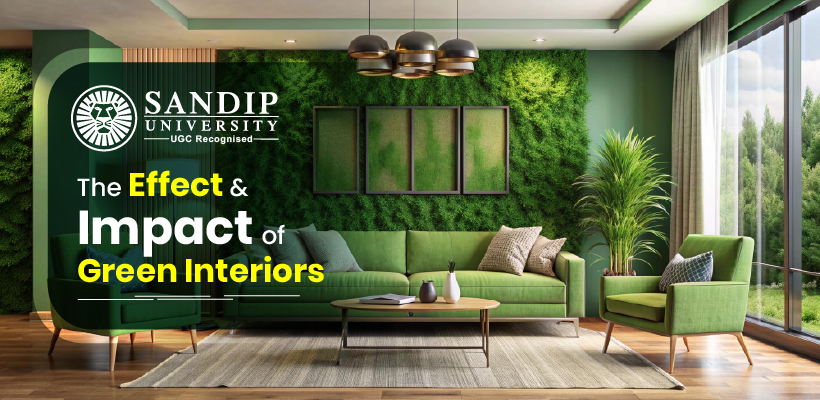Green interior design is need of today’s context due to harsh changes in climatic conditions so there is need to focus on Creating sustainable and productive spaces is the goal of green interior design. The globe is trending toward renewable and environmentally friendly resources as a result of natural resource depletion and the harsh realities of global warming. While double-glazing and other energy saving design features rate highly in terms of energy savings, it is eco-friendly materials and products that are reaching new levels of popularity in the country. Some of the top interior design colleges in Nashik are focusing on colour themes and integration of colours into the curriculum to train students in this area of interior designing. Let us explore the effect and impact of green interiors:
Importance of Green Interior
Green interior design isn’t just a trend; it’s a commitment to making environmentally responsible and resource-efficient decisions throughout the design process. It is about planning interior spaces that are aesthetically pleasing and healthy for the user and nature.
The Impact of Green Interior Design
As in a growing number of developing countries, the Indian industry is welcoming the presence of green building practices throughout its various sectors. While green implementation was first seen in the architectural design and construction stages, green interior design is now trending as a highly fashionable choice. Today the upcoming phase is opting for green interiors which can be also said as sustainability. Going green is seen as a ‘trendy’ option for Indian clients, who appreciate the aesthetic and environmental impacts of eco-friendly products and materials.
The residential market is handling environmentally responsible design through simple retrofitting, with many clients opting to install organic and sustainable timber, bamboo, grasses, wicker and jute. Such material both aid in removing toxicity from interiors and keep product sourcing local. Natural fabrics such as leather, cashmere and angora are also on the rise as in terms of use in furniture and fittings.
India is seeing strong growth in replacement products, such as low volatile organic compound materials and paints in place of high toxicity products and eco-friendly particleboard made of compressed industrial waste. Small and at-home changes are having the greatest impact on the growth of a green building sector in the country, with industry professionals who understand this notion benefiting greatly from increased clientele.
Fundamental Principles to Green Interior Design
The Triple R Approach: The foundation of sustainable design is simple yet efficient: Reduce, Reuse, Recycle.
- Reduce: Choose designs and products that use less energy and materials to create in order to minimise waste.
- Reuse: pick items that have numerous uses, letting them to introduce new life into your design scheme.
- Recycle: To decrease the need for virgin resources, include materials that can be reused back into the manufacturing cycle
Benefits of Green Interiors
In one human being needs 2.9 kg of oxygen (02) so that the plant helps speed up the procurement of 02 in the room during the day. Here are the benefits of green interiors:
- Enhance occupant’s well-being and productivity
- Reduce liability associated with poor indoor air quality
- Increase marketability
- Decrease churn costs
- Lower operating and maintenance costs
- Provide thermal comfort
- Provide access to daylight and views
Conventional Eco-friendly Material
- Bamboo, ply board, bamboo matting
- Bricks suns dried
- Clay roofing tiles
- Gypsum board, tiles, plaster, blocks, gypsum plaster fibre jute/sisal and glass fibre composites
- Marble mosaic tiles
- MDF boards and mouldings
- Partial boards
- RCC door frames
- Rubber wood finger joint board
- Stone dust
Objectives of Green Interior
Reducing energy bills is a central tenet of green interior design. For most homes, the main source of energy is electricity from the central power grid. The vast majority of electricity in the world is made by burning non-renewable fossil fuels.
The other problem is that burning fossil fuels produces greenhouse gases that are causing climate change which is playing havoc with man’s attempts to grow food, destroying animal habitats and endangering a wide range of eco-systems.
Opting to go ‘off the grid’ by installing solar panels and wind turbines is one solution. Another is to only buy green energy made from alternative energy sources. For most homes neither of these options is viable. Instead, the best we can do is to reduce our energy consumption.
This can be done by using a programmable thermostat, by not leaving your electrical products on stand-by, by properly insulating your house, by replacing your incandescent light bulbs with compact fluorescent light bulbs, by turning up your cooler in the summer and turning down your heater in the winter, by washing your clothes in cold water, by buying appliances with the Energy Star mark, and by doing a hundred other small things to save energy.
Conclusion
The right selection of materials and finishes for each and every element of an interior is totally under the discretion of a designer who have nothing to lose and plenty to gain from embracing sustainable design. In order to create an environmentally sustainable interior, designers must consider the environmental impact of the materials which they plan to use in the interior; encourage recycled-content materials, avoid endangered tropical hardwoods and limit VOCs that harm human health. Pursuing B.Sc. Interior Design and Decoration from a leading design college can help you understand the impact and effect of different kinds of interior designs.
Avoiding chemicals, for example in paints and fabrics, including plants, daylight and natural ventilation promote wellbeing. Interior designers also can influence the energy efficiency and water consumption of buildings in use by selecting low-energy and water-saving products. From this research it can be concluded that sustainability must first and foremost be present in the design of interior architecture to improve human health and minimise the adverse effects on our environment.

